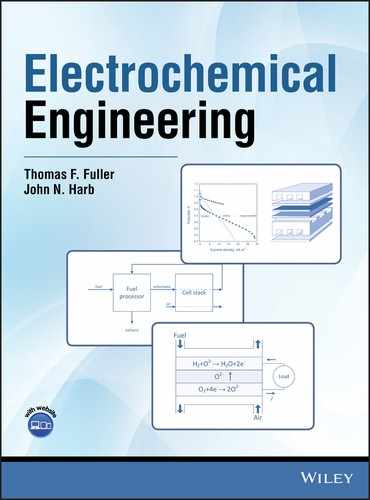Preface
Given the existing books on electrochemistry and electrochemical engineering, what do we hope to accomplish with this text? The answer is twofold. First, it is our goal to provide enough of the fundamentals to enable students to approach interesting problems, but not so much that new students are overwhelmed. In doing this, we have attempted to write with the student in mind, and choices regarding content, examples, and applications have been made with the aim of helping students understand and experience the important and exciting discipline of electrochemical engineering. The text has a large number of worked out examples, includes homework problems for each chapter, and uses consistent nomenclature throughout in order to facilitate student learning. Our second objective is to integrate key applications of electrochemical engineering with the relevant fundamentals in a single book. We have found applications to be of great interest to students. Importantly, applications provide students with the opportunity to practice in a meaningful way the fundamentals that they have learned. We have made a deliberate effort to tie the investigation of the applications directly back to the fundamental principles.
The book is intended for senior-level engineering students and entering graduate students in engineering and the sciences. No knowledge of electrochemistry is assumed, but an undergraduate training in thermodynamics, transport, and freshman chemistry is needed. A basic knowledge of differential equations is also recommended. Historically, electrochemical engineering is closely associated with chemical engineering and chemistry. However, the lines between disciplines are becoming increasingly blurred, and today we find mechanical engineers, material science engineers, and physicists engaged in electrochemical engineering. We have attempted to broaden our view of electrochemical engineering both to appeal to a larger audience and to expand the exposure of students to new areas and opportunities.
The text is divided into two parts. The first six chapters cover essential topics in a familiar order: an introduction, thermodynamics, kinetics, and mass transport. Also included in these fundamentals is a chapter on electrode structures and one on electroanalytical techniques. The remaining chapters cover applications of electrochemical engineering. It is assumed that the student will have mastered the fundamental chapters before starting on the applications. The application-focused chapters comprise batteries, fuel cells, double-layer capacitors, energy storage systems for vehicles, electrodeposition, industrial electrolysis, semiconductor electrodes, and corrosion. For the most part, the instructor can pick and choose which application chapters to cover; and these applications can be presented in any order. Although not exhaustive, the applications selected represent important applications of electrochemical engineering.
Each chapter begins with a short biography of one of the founders in electrochemistry and electrochemical engineering from the twentieth century. Even though not essential to the technical material presented, writing these short sketches was often personal and deeply satisfying. In general, our focus was on the accomplishments and impact of these remarkable individuals. The selection of whom to profile was also personal and, without question, subjective. Other than space limitations, there can be no justification for omitting pioneers such as Alan Bard and Norbert Ibl.
The authors have used this material to teach introductory electrochemical engineering courses at Georgia Institute of Technology and Brigham Young University. Many of the chapters were drastically revised after the first teaching. Again, our objective was to create a textbook suitable for classroom teaching. Many of the problems presented at the end of the chapters have been honed through homework assignments and on examinations. In fact, these problems and our lectures guided what content to include in the text—we sought to eliminate from the book content not addressed in class or not suitable for practice in the form of problems. Our experience has been that in a one semester course only a couple of the application chapters can be completed in addition to the first six fundamental chapters. We have purposely included references only sparingly in the text itself. While important references for each topic are found at the end of each chapter, we made no attempt to meticulously ascribe credit—our thinking was a highly annotated text is not important to beginning students and actually presents an additional barrier to learning.
The journey of writing this book has been immensely rewarding and not surprisingly a bit longer than anticipated. We have so many colleagues, students, friends, and family members to thank. Their support and encouragement was beyond heartening.
Thomas F. Fuller
2017
John N. Harb
